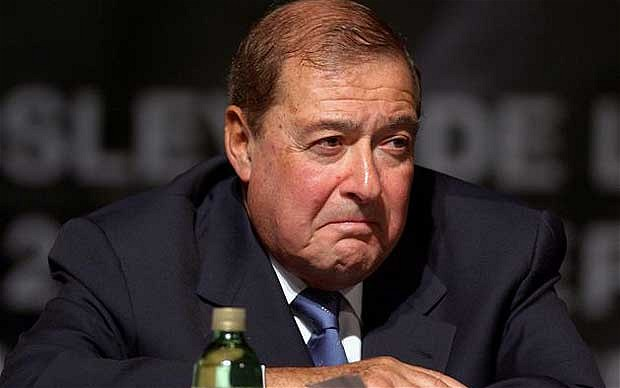Bob Arum has played the bad guy role in boxing for a long time. Not that he’s a bad guy per say, but he has become the unrequited figure in boxing that has allowed the media and fans to point the finger at him during times of hardship, the perennial Scarface or Razor Ramon as it were.
I don’t believe he relishes the role and he may not even fully understand or agree with how he is generally perceived, but then again he isn’t really as in tune with the fans as he may think. There’s no doubt that Arum is a smart business man, a smart man in general. And, of course, he knows the business of boxing, and boxing in general. But social media and the evolution of the internet has done to Arum what the furtherance of technology tends to do to the older generation, it has disenfranchised him.
Much has been made of Arum’s comments over the past few weeks, specifically his estimation of fans that care about PPV undercards, perhaps his rationality extends to undercards in general. He puts the percentage at 10, but what was unspecified was the original origins of that 10%. Where did he take it out of?
Was it 10% of those that buy the PPV card? Was it 10% of those that actually watch the fight, because that number is vastly larger than the tally of PPV purchases. Was it 10% of boxing fans worldwide? Was it 10% of anyone even remotely interested in sporting events? Or was it merely a way of letting hardcore fans know that they make up a very small demographic when the bigger picture is focused upon? I lean towards the latter.
We can assume that wherever his original arithmetic came from, the truth is he is right, regardless of whichever pie he decided to cut from.
Boxing is not a dead sport, it is more like a patient in critical, but stable condition at the end of the hall. The one that nurses check on after a major procedure, but is pretty much left in the hands of those involved with the everyday routine once vital signs are stabilized.
What Arum doesn’t understand about that 10% is they are so much more important than the other 90 because they aren’t as exchangeable. The 10% he spoke of are the devout, they are the ones that never miss a fight and you can pretty much count on all of them for any event ever, they are sickos. I should know because I’m in that group and I know the lengths I’ve gone through to watch a fight live. My aunt may never forgive me for missing her wedding reception, but Pacquiao destroyed Hatton and I wouldn’t have forgiven myself for missing it, she gets me crappy Christmas gifts anyway.
The 90% however, are a fickle bunch and very unpredictable. They are constantly swapping in and out with other “90%” type fans. They are the ones that don’t mind reading the results in the morning or catching the highlights on ESPN.
I wouldn’t presume to explain or teach Arum a thing about business, but I think a smart man would stop trying to find the middle ground in pleasing the 9 to 1 crowd. A smart man wouldn’t focus his attention on the 90% of casual fans and alienate the 10% of genuine fans, he would instead try to recruit from the 90 and turn them into 10percenters. Do not focus on the fundamentals of demographics and mainstream marketing and instead turn the 10% into 50%.
You can only do that by focusing on the undercards with a finer microscope, building like the way the opening band does at a concert. Once upon a time bands like Greenday, Beastie Boys, and the Red Hot Chili Peppers were the opening act. Kendrick Lamar opened up for Eminem 4 years ago and Eminem opened up for Dr. Dre before that and N.W.A. opened up for some rapper that nobody has ever heard of before that.
It isn’t strictly about building a card around one fight, it is about building on a brand of great fights. Arum said that some people don’t care or even watch the undercard, which is only true because he has been giving us mostly crap undercards for a long time. He is responsible for the disinterest.
The other aspect to Arum’s theory that is flawed is his understanding of the psychology of those 10%.
What PPV boxing and MMA have in common with the entertainment industry is the amount of pirating that goes on across the board. Kanye West, Brad Pitt, Anderson Silva, and Manny Pacquiao would all do better numbers if pirating wasn’t an issue.
The problem is pirating music, movies, and PPV events has become decriminalized a bit over the years because of how much easier it has become. You used to have to be a bit more computer savvy to find the right stream online, the one that wouldn’t get shut down minutes into an event, or the one that had legible quality, or the one that wouldn’t give your computer a virus.
Now, it is so easy to find and download torrents that your problem isn’t finding the right PPV stream, it’s deciding between them all.
What Arum and people in his shoes don’t understand is boxing attracts the most intellectually sound minds in the first place. I’m not saying every boxing fan is a “beautiful mind,” but I am saying that hardcore fans are mostly comprised of free spirited, outside the box thinkers. These boxing fans aren’t like the huddled masses that watch the Super Bowl, they are turned off by the commercial appeal of the NBA or the historical significance of the MLB. They love boxing in part because no one else gets it.
It takes a special mind to appreciate boxing, the kind of mind that can figure their way around a keyboard or at least enough so to stream a PPV event every other month.
True, focusing on the 10% will do little in bringing some of the pirates to their moral decision making. The fact is most are too far gone to rationalize a reason to stop getting free PPV. But I guarantee you could make a dent if you put forth a bit of effort, at the very least you could stifle the young and impressionable fans of the future.




